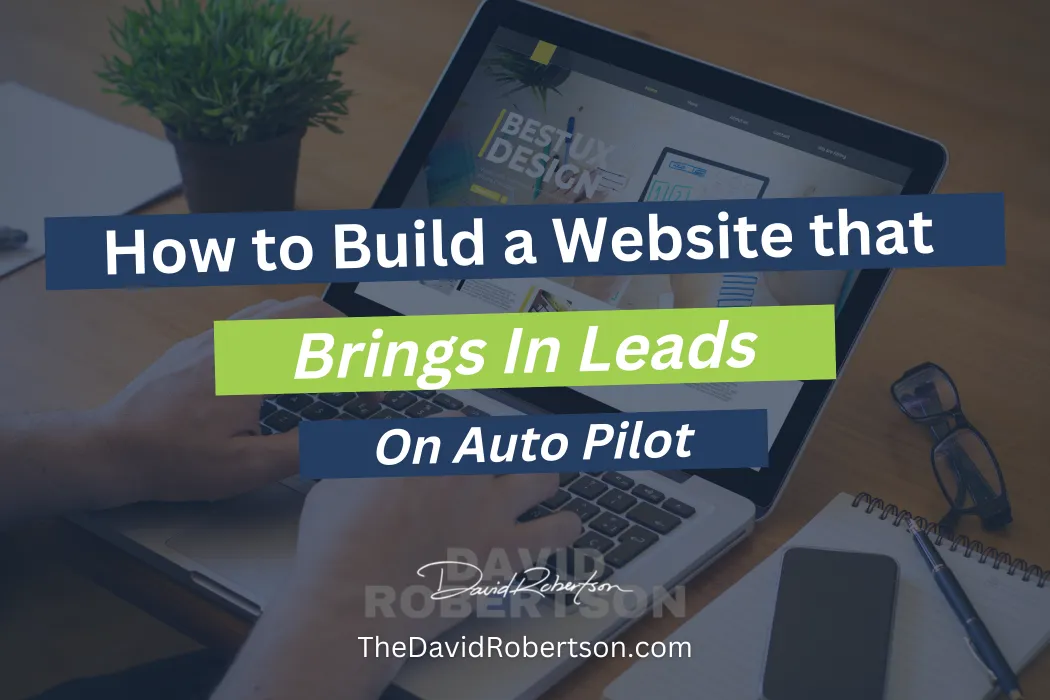
How to Build a Website That Brings in Leads On Auto Pilot
You’ve invested time, money, and creative energy into your website — but here’s the truth most business owners don’t want to hear:
If your website isn’t bringing in leads, booking calls, or helping close deals… it’s not an asset. It’s an expense.
It might look great. It might even impress your peers. But unless it’s doing the real work of selling — like a trained salesperson would — it’s just sitting there. Quiet. Passive. Expensive.
Meanwhile, your prospects are Googling solutions at 10:47 p.m. after their kids are asleep. They’re researching. Comparing. Deciding — often without ever picking up the phone.
That means your website is either selling for you while you sleep…
Or it’s quietly handing business to your competitors.
So how do you build a site that doesn’t just look good, but actually works?
Let’s break it down.
Start with the Five Second Test
This is the first thing I do when evaluating a website for any client. I call it the Five Second Test — and it’s exactly what it sounds like.
Show your homepage to someone for five seconds. Then close it. Now ask them two questions:
What does this business do?
What should you do next if you’re interested?
If they can’t answer both clearly, your website is failing at its first job. Clarity isn’t optional. It’s the foundation of every sale. A potential customer should be able to immediately understand who you help, how you help, and what action to take next.
Make your website start conversations
Think about your best salesperson. They don’t just hand someone a brochure and walk away. They engage. They ask questions. They find out what the person really needs.
Your website should do the same. It should offer a two-way experience, not a one-way presentation.
This could be a live chat feature. A quiz that points people toward the right service. A downloadable guide or checklist that solves a pressing problem. These aren’t gimmicks — they’re door openers. Real conversations lead to real conversions. If your site isn’t designed to spark interaction, it’s not selling. It’s simply speaking into the void.
Build behavior-based follow-up
Here’s where most companies leave money on the table.
Imagine a visitor returns to your service page three times in one week. They scroll all the way down, spend time reading, then leave again.
What happens next?
For most websites, the answer is: nothing.
A smart website is connected to your CRM and email marketing tools. It tracks behavior and uses it as a signal. That repeat visitor should be tagged, enrolled in a targeted email sequence, or flagged for a follow-up call.
Salespeople do this instinctively — they follow up when someone shows interest. Your website should do the same. With the right tech, it can.
Use AI to pre-qualify and convert
This is where the best websites are pulling away from the pack.
Today, AI-powered tools can guide visitors through a personalized journey. They can ask qualifying questions, make smart recommendations, and even schedule calls directly on your calendar — all without human effort.
Think of it like a digital sales development rep. One that works 24/7, never forgets a follow-up, and treats every visitor like your best prospect.
This isn’t theory. It’s available now. And the businesses using it are already seeing results.
Real story: How One Electrical Contractor Flipped the Switch
I worked with an electrical contractor whose website checked all the boxes — from a designer’s perspective. It looked clean. It had a modern layout. But it wasn’t generating leads. It wasn’t starting conversations. And it definitely wasn’t closing business.
We applied the exact framework I’ve just shared. We rewrote the messaging to pass the Five Second Test. We built in real engagement tools — a chat module, a diagnostic quiz, and downloadable resources. We connected everything to their CRM. And we layered in AI to guide and qualify new leads.
The result?
In the first week, they received multiple new requests for bids and had project walk-throughs automatically booked on their calendar.
Nothing else in their business changed. The only difference was that their website started acting like a salesperson.
Here’s the bottom line
A website that looks good but doesn’t sell is a liability. It’s the digital equivalent of hiring someone who dresses well but doesn’t know how to close.
The websites that consistently bring in qualified leads all have four things in common:
Clarity. Engagement. Automation. And AI.
If your website isn’t working like a salesperson, it’s not doing its job.
And it’s not going to fix itself.
Start with the Five Second Test. Show your homepage to someone who doesn’t know your business, and ask what they remember. If they can’t tell you what you do and what to do next, start there.
And if you want help rebuilding your site into a system that sells while you sleep, reach out. I’ll walk you through the same process I use with my clients — and help you turn your most expensive brochure into your best performing salesperson.
